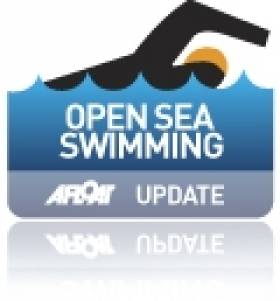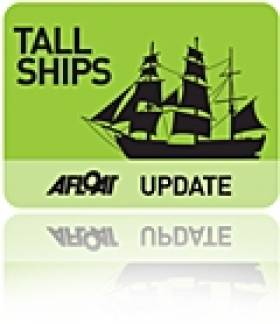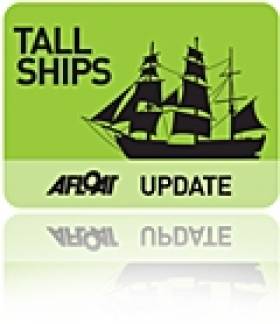Displaying items by tag: Irish Maritime Festival
Drogheda Sail Training Bursary Presentations Marks Fifth Year of Local Youth Initiative
#SailingBursary - As part of the Drogheda Sail Training Bursary Presentations to mark the fifth year of the local youth initiative a large gathering was held to celebrate the event.
The gathering was the largest ever event held in Drogheda for young sail trainees with over fifty trainees attending from three stunning vessels, the Irish Brian Boru, the English Maybe (as pictured) and the Russian Shtandart.
This year the Brian Boru arrived at the Irish Maritime Festival (held in mid June) carrying the first crew of Drogheda sail trainees who were being awarded with their achievement certificates at the event. They had spent five wonderful days sailing up the east coast learning new life skills and once on land they finished it off with a guided walking tour of historic Drogheda given by the Old Drogheda Society. The Russian trainees were particularly intrigued with the head of Saint Oliver Plunkett.
The Mayor of Drogheda welcomed all the trainees in from sea and also extended a warm welcome to the second group of young seafarers as they prepared to set off on their own adventure on the seas on the second bursary sail north. He acknowledged the importance of this bursary for the youth of Drogheda and surrounding areas and how it has opened the doors to the many maritime opportunities out there. ‘Meeting these new young mariners in the making along with their local corporate sponsors is testament of how much this youth development program has grown since its maiden voyage back in 2013’ said the Mayor.
MC for the evening, Nessa Lally of Drogheda Port Company thanked Sail Training Ireland for their role in making this bursary a success every year and extended a massive thank you to the four sponsors of the ‘Drogheda Sail Training Bursary’, Fast Terminals Ireland Ltd, Irish Cement Ltd, Louth County Council and Drogheda Port Company. This year these sponsors merged to form the Drogheda Sail Training Bursary scheme with a strong public private partnership approach and further develop the initiative into the future. ‘It is very heartening to see the interest these local companies take in the development of opportunities for the youth of the town.’
Captain Peter Scannal of the Brian Boru and trainee Rowan Latimer from Bettystown outlined the adventures and experiences they had on board the vessel to everyone assembled. It was a wonderful evening as finally all the incoming trainees were presented with their certificates of achievement by the bursary sponsors.
Stowaway Sessions on board Tall Ship Earl of Pembroke
One of the musical highlights of the recent Irish Maritime Festival in Drogheda were the two unique sold out concerts held on the deck of the Tall Ship Earl of Pembroke on the historic River Boyne.
The idea for the Stowaway Sessions on board a Tall Ship began over four months ago and the project was co-ordinated by the Drogheda Port Company in conjunction with the Droichead Arts Centre. SJ McArdle and Adrian Taaffe were the inspiration for the musical talent on both nights.
On the first evening Alt-pop pair Heathers brought their beautiful harmonies on board and they were supported by local band the Carolan Brothers.
The vessel provided a unique venue which was appreciated by both audience and artists alike and added so much to the experience.
Steve Wickham and his band brought his unique style of music and fiddle playing on board on Saturday night and showcased a number of new songs which reverberated through the ships timbers. He was supported by another local band, Kern who looked and sounded totally at home on a Tall Ship.
The vessel arrived into Drogheda Port on Friday 9th June and within two hours was transformed into a concert space. A number of logistical challenges were overcome with the help of an enthusiastic crew, the hatch cover over the hold acting as the stage and the hold itself becoming a once off green room for the artists.
The entire experience was a tremendous success and went without a hitch. The Earl of Pembroke set sail from Drogheda on Monday 12th June taking with it the memories of two unforgettable evenings.
Full Steam Ahead As Maritime Festival Gets Sponsorship
#TallshipsDrogheda - The Irish Maritime Festival in Drogheda which has drawn thousands of visitors to Boyneside received a major boost with the official announcement that Maxol, has come on board as the festival's main sponsor.
Last year over 37,500 people of all ages visited the festival which offered many attractions along Drogheda Port, including vintage vessels, the Drogheda Motor Show, artisan food market, maritime history, live entertainment, pirate battles and the Boyne Swim.
Expectations are high that this year's festival, which takes place in Drogheda from Friday-Sunday, June 19-21, will surpass that attendance figure with full programme details to be announced later this month.
Involved since its establishment, Louth County Council, is now a main funder and programme manager of the Festival which is hosted in conjunction with Drogheda Port. Both the Council and Port warmly welcomed Maxol's major commitment to The Irish Maritime Festival.
Denis Moynihan, Chairman of the port, said "On behalf of Drogheda Port Company, I welcome the Maxol Group to the growing Irish Maritime Festival family. In playing a vital role in this annual festival, Drogheda Port welcomes the renewed focus on the town's unique maritime culture and heritage.
He added, "the Festival is a considerable co-operative undertaking each year and we look forward to what will be the biggest and best festival yet."
River Boyne Swim Won By Wicklow Triathlete Brian Harris
#boyneswim – The inaugural Boyne swim which was held as part of the Irish maritime festival was won by nationally acclaimed swimmer and tri-athlete Brian Harris, Base2Race, from Ashford Co Wicklow who won the race in a time of 27.46 Minutes. The overall winning female was Rachael Lee from Dublin and the overall junior was Muiris O'Murchadha also from Dublin aged 17.
Over 150 swimmers participated in the race and the course was 2.7km on the river
Boyne going throught he centre of Drogheda and the Port and finishing South East of the famous Viaduct Bridge. It was organised by the Drogheda Triathalon Club in conjunction with Drogheda Port Company. The race is set to become part of the annual swim calendar and will join the Liffey and DunLaoighre Harbour elite swims.
The perpetual trophies for the three winning categories of the inaugural Boyne Swim were sponsored by Drogheda Port Company and have been exclusively designed and created by well-known Drogheda sculptor, Ronan Halpin who grew up on the banks of the river Boyne. He now resides in Keel, Achill Island where he showcases his stunning and unique artwork in his own public art gallery. He draws his inspiration from his maritime surroundings.
#DroghedaTallShips- Now that the tallships in Drogheda Port have departed, the memories remain of ketches stretched along quaysides that also date back a century ago and longer, writes Jehan Ashmore
The 1904 built West Country trading ketch, Bessie Ellen, was one of the seven majestic sailing vessels to attend the event officially titled The Irish Maritime Festival. The three-day event follows last year's inaugural festival.
Thousands were drawn down to the quays where the eclectic gathering of vessels had berthed along Merchants and Steam Packet Quays. Both quays conveniently within reach for pedestrians to stroll along from the heart of Drogheda town centre and to where the quays end at the foot of the railway viaduct.
Making an appearance on the Saturday was the Irish-flagged Spirit of Oysterhaven, the 70 ft schooner is Ireland's only 'non-naval' sail training vessel which slipped under the Dublin-Belfast railway line. She berthed close to the 80 year old Soteria with a white hull and red band while alongside her was the all black schooner Vilma.
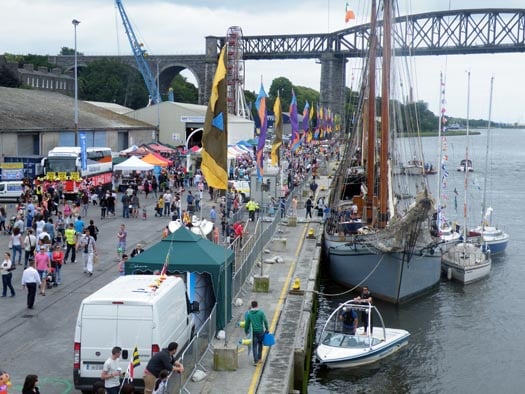
The distinctive light grey hull of ketch Irene, seen moored alongside Drogheda town quays
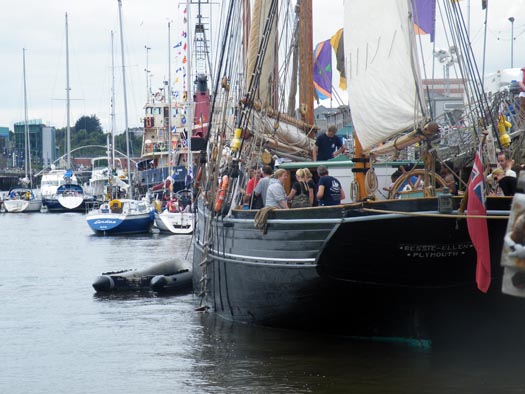
Festival-goers roam the decks of Bessie Ellen and berthed ahead the hopper dredger Hebble Sand
Arguably the most rustic of the flotilla was the gaff-ketch former trawler Keewaydin which this year celebates her 101st year on the water. She had sailed from Dun Laoghaire Harbour having departed from her last UK port in Falmouth. Berthed ahead was the former Baltic trading ketch Ruth which as previously reported anchored off Dalkey in recent weeks.
The third and final ketch caller was the light-grey hulled Irene of 1907, which took part in last year’s 'Sail Home to Your Roots' event as part of the Gathering.
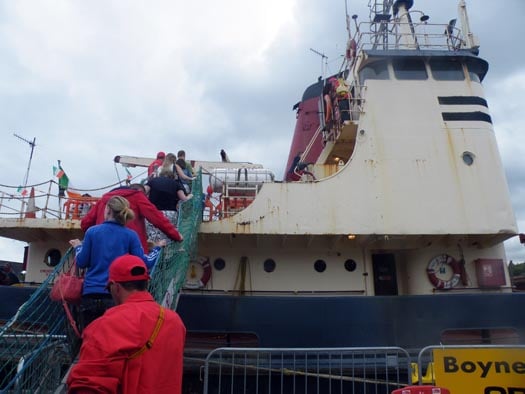
Another classic vessel, albeit without sails, the 'Hebble Sand' (pictured above) is a grab-hopper dredger built in 1963 which was made open to the public. The opportunity gave visitors a greater insight into the working operations of the 757 tonnes vessel which remains employed after more than five decades serving UK and Irish ports.
Her most recent job was carried out at the festival's host port in which Afloat.ie previously reported. The Dundalk-registered vessel is from where for many years she was based in the neighbouring Louth homeport port until sold to current owners Abco Marine.
#TallshipsBerthBoyne-This morning five beautiful tallships are arriving at the mouth of the Boyne for the second Irish Maritime Festival held along the town quays of Drogheda this weekend (13,14 and 15 June), writes Jehan Ashmore.
Once all these tallships are assembled alongside the quays, Drogheda can look forward to officially opening the festival where as previously reported, a special cargo of Scottish Whiskey is on board the classic West Country ketch Bessie Ellen. The 100 year-old built in Plymouth had sailed from Islay to include en route call to Peel on the Isle of Man.
The whiskey bottles are from the Bruichladdich Distillery on the Hebridean island, which are to be presented to the Chairman of the Port Company, the Mayor of Drogheda and the Captain of the Bessie Ellen.
The 'cargo' event is to symbolise and re-establish the historical trading links between Drogheda's town quays and Islay. For more than 500 years, the Louth port can trace the industry of distilling and trading links. Working sailing vessels such as Bessie Ellen would of shipped barley and grain to supply Scottish distilleries dotted along the western Isles.
Following the above launch, the celebration of the seafaring three-day maritime feast is to embark with events among them full-scale 'pirate ships' battling on the river, a coastal rowing race, show-stopping water-sports and the Boyne swim.
A Maritime Pavilion plus a host of cultural and family entertainment will accompany the tallships. Among them the 120-foot long grey-hulled Irene which is to berth on the town quays with the railway viaduct presenting a backdrop of an iconic local landmark.
Also throughout the weekend you can visit the Maritime Education, Enterprise and Careers Centre with the Naval Service represented, to learn more about our coast and environment and the interesting maritime careers available.
Very much keeping to the sea, there will be an urban beach offering the chance to create the ultimate sandcastle while expert sand-sculptors will be at hand working on their creations.
#SailingWhiskey- In her centenary year, the classic West Country ketch Bessie Ellen will be very much keeping to her original role when she carries cargo, notably precious whiskey from Scotland to Drogheda for the Irish Maritime Festival held next weekend (13,14 and 15 June).
The whiskey is from the Bruichladdich Distillery on the Hebridean island of Islay and is also from where a cargo of barley will be carried to symbolise and re-establish the historical trading links between Drogheda's town quays and Islay.
Uon arrival to the festival, bottles from Bruichladdich will be presented to the Chairman of the Port Company, the Mayor of Drogheda and the Captain of the Bessie Ellen.
It is fitting that Bessie Ellen which would have been the very type of vessel to be involved in this trade a 100 years and that of transporting thousands of tonnes of barley and grain exported from the Louth port to the distilling industry along the Scottish western isles.
As previously reported on Afloat.ie she was expected to take week-long voyage where people have an opportunity to sail on board one of the last surviving trading ketches from a fleet of over 700. She hails from an era when working sailing ships were an everyday sight seen trading in Irish ports and harbours.
As owner-master, Captain Nikki Alford explained (also click for video) she regularly carried cargoes among them timber pit-props,coal, china-clay and grain for Guinness. In response to the current cargo carrying voyage she said "We are so looking forward to bringing this special cargo back to Drogheda and very excited at being part of the Maritime Festival."
CEO of Drogheda Port Company, Mr Paul Fleming stated 'This is a fantastic and very authentic way to commemorate Drogheda's rich maritime history. There are over 560 years of distilling, trade and transport history represented between the port, the ship and the distillery. It is thrilling to watch all of this heritage being brought to life at the festival'.
Bruichladdich distillery was established in 1881 and continues to this day to use only the finest barley and traditional distillation methods to produce their world class whisky. Their passionate belief in provenance and the barley itself has resulted in the production of the iconic Bruichladdich Islay Barley 2007 malt whisky where the grain for the whiskey was grown on a local farm beside the distillery.
Master distiller from Bruichladdich distillery Jim McEwan said "we are delighted to be associated with Drogheda Port and the Irish Maritime Festival. This is a fantastic opportunity for us to ship our whisky in the old fashioned way, by sail."
Hop Onto the 'Hopper' at the Irish Maritime Festival
#IrishMaritimeFestival– In addition to all those tallship's at the Irish Martime Festival (13,14,15 June) in Drogheda Port, another classic vessel, 'Hebble Sand' a grab-hopper dredger built in 1963 will be open to the public.
The 757 tonne veteran at more than half a century old, has had a long and colourful working history. She is still operating having worked for more than five decades throughout Irish and UK ports. As previously reported on Afloat.ie, she is finishing a dredging campaign in Drogheda Port just in time to join the spectacle of tallships vessels on view to the public.
Access to the public of Hebble Sand, will give a real feel for a working ship and that of the operational side of port related activity. She is one of the last dredgers of its type and age, having been built in 1963 from Richard (Shipbuilders) of Lowestoft.
She was sold to Abco Marine in 2012 following her sale by Dublin Port Company, though her career in recent years had been with Dundalk Port. Almost two years ago she made her first voyage since her sale from the capital bound for the Mull of Kintyre.




























